

Past mushrooms of the week will be at the bottom and stack up to the most recent week at the top. Updated on Sundays.
Disclaimer!! I am not a mycologist and this page is really just some half-assed compiling of google results. Do not eat any mushrooms or make important fungi-based decisions based off my website.
Homepage
Images are in the public domain unless otherwise credited
Mycosarcoma maydis, or Huitlacoche (05/04/25-05/10/25)
This mushroom infects corn, but it does humans the favor of being food in and of itself! It's got to be one of the most considerate crop blights on the planet! I really want to try this one and I'm going to be on the lookout this summer for sure. Its entire genome has been sequenced and it has been used as a model organism in gene studies. It seems like an underappreciated gem to me. I hope you're finding people who recognize your value and recognizing the special things people in your life shine at!
Hericium erinaceus, or Lion's mane (12/01/24-12/07/24)
!! I've eaten this one in a shake in California one time. It's a little sad the taste was covered up by everything else in there, but the drink was really good so I forgive them :). I highly reccomend browsing the wiki for this species. Many people eat lion's mane mushrooms and I see them as a friendly species. Like the golden retriever of mushrooms lol. They're even fuzzy looking. The wiki talks about how you can grow wild strains in petri dishes? I've only had a bit of experience culturing bacteria so I didn't know you can use very similar methods for some fungi. I recently also saw this mushroom for sale in a grocery store, but I didn't buy it. I kinda wish I did now so I could experiment with cultivating spores from it if thats even possible? I hope you're headed into the holidays with a warm fuzzy feeling growing in your heart. Not a fungal infection. Unless you're into that... uh. Cheers!
Auricularia delicata, or Deer tripe mushroom (07/21/24-07/27/24)
This mushroom is edible and good for your liver and digestive system! It's cultivatable and has been used as medicine in many places. I found a cool article from 2021 (here) about a sugar molecule found in the mushroom that is totally unique and goopy. Hu et al. point out that it could be used in rheology to help the food industry change the texture of foods. The viscosity of the polysaccharide increased with the temperature--meaning it could be used to hold food together so it doesn't fall apart while cooking.
On a personal note I broke my leg really badly a few weeks ago and I had a few surgeries. I won't be able to walk for at least another month. Obviously I'm pretty bummed about it and the whole thing was (still is I guess) kinda traumatic. But! Everything is healing well and I may be able to put weight on my leg before school starts again so like the mushroom goop I'm holding it together! I'm still cooking hehe :) Anyway thanks for reading my infrequent mushroom musings and I hope everything gels together for you this week!
Collybia nuda, or Wood Blewit (06/02/24-06/08/24)
This species has been classified by a few different names in the past as seems to be the case with taxonomic organization of most fungi. The wikipedia page for it says this mushroom smells like frozen orange juice. They are edible and apparently tasty! Also, they can be cultivated which is pretty unique and awesome. My sister says I "would blewit" if I didn't choose this mushroom for this week so. I hope you hear an even better pun than that this week! :)
Mycena rosea, or Rosy Bonnet (05/26/24-06/01/24)
It's a pink mushroom week hell yeah! The color of this mushroom comes from its special pigments: mycenarubin A and mycenarubin B. They are unique to this organism and aren't found in other natural sources. The mushroom reportedly smells like radishes and tastes like them too--though they are not edible because they contain the toxic molecule muscarine.
Tremella mesenterica, or Witches' Butter (05/19/24-05/25/24)
This mushroom is super neat. It's edible raw or cooked but it's said to be flavorless. It shows up on logs (not living trees) after rain and shrivels away as things dry up. They can re-hydrate again with more moisture. They're pretty small and only grow to about 3 inches long. They're associated with witches in some places. They don't actually eat the dead wood they live on, but they eat different fungi (which is eating the wood) in the Peniophora genus. It's an example of hyperparisitism which I've been learning more about recently. Being a parasite is a pretty sweet deal in nature I guess! I just finished reading the Dungeon Meshi manga today after being swept up in a little bit of a whirlwind obsession with it lately, so I'm having a hard time extrapolating a cute little message for the week based on this species--instead I'm just remembering the chapter about eating a parasite of a parasite not going too well! Borrowing from that story I guess I hope that this week your stomachs stay settled and you eat well! :))
Flammulina filiformis, or Enoki (05/12/24-05/18/24)
These mushrooms are for eating! I feel that they're tastier than the portabello. They're a little sweeter in my opinion. The ones you buy from the grocery store are tall and thin because they are grown in darkness, if they have exposure to sun, they're stockier in shape and change color! Also, the trace minerals and metals in the media the mycelium is grown in can affect yield for this species. Increasing magnesium, for example, can help farmers grow more product and also their fruiting bodies will contain more nutrients for consumers. These mushrooms remind me to stretch! Reaching for the light even when it may not be there at the moment is a great practice.
Trametes versicolor, or Turkey Tail! (11/19/23-11/25/23)
Just realized Turkey Tail mushrooms are very on theme for Thanksgiving. The brief inter-hiatus mushroom of this week is a beautiful polypore that I'm thankful to share the planet with. Polysaccharide-K is a substance extracted from this species and used with cancer therapy, and as a supplement in some places. Traditional Chinese medicine uses Turkey Tail mushrooms too. However, it's not a great idea to forage and eat the mushrooms themselves, as they have a ton of look-alikes, and may not be all that effective for health in many circumstances. A cool thing to see with this mushroom is that it looks like it turns green when it gets older if algae grows on its surface. Just like this fungus eats dry dead wood, I hope to eat dry dead turkey tomorrow and for several days afterward :)) I love leftovers. I hope you have a joyous end of November and good luck with final exams if you've got 'em!
Cantharellus cinnabarinus, or Red Chanterelle. Aleuria aurantia, or Orange peel fungus. Gliophorus psittacinus, or Parrot Waxcap. Cortinarius porphyroideus, or Purple Pouch Fungus. Agaricus deserticola, or Gasteroid agaricus. (09/24/23-now)
5 weeks of no mushroom updates? RIP. I'm on that grind at school and work and in my comedy club. I'll put a few species in this update and they may have to be all we've got until school goes on break again.
Red chanterelles are a goregous golden red color with a pink spore print! They're edible and grow in North American forests. They have the distinctive false gills that give chanterelles their charming and easily-reconizable silhouette.
Orange peel fungus is my Halloween themed species for this year because not only is it the color of a jack-o'-lantern, but it's shaped like a cup you could carry around for trick or treating. It grows on clay and makes me want to get creative with bright colors for my costume this year.
Parrot waxcaps are so cool looking. Some of the slimiest guys ever. What's their deal? We may never know because habitat destruction is threatening their chances of survival as a species.
Purple pouch fungus! These only grow in New Zealand and they're one of those neat kinds of mushrooms that get eaten on purpose to spread their spores through bird poop. When the mushroom grows it starts out white and exposure to sunlight turns it purple. They pretty much only grow with beech trees in one place on earth.
Like the purple pouch, A. deserticola is secotioid and doesn't shoot out its spores. It dries out until the top breaks open and waits for the spores to be blown away in the wind. It is distributed in the southwest and western U.S. (and Mexico!) so I may encounter these in the future. They are adapted to super dry environments and can grow in straight up sand. Their edibility status depends on who you ask... I wouldn't risk it. They're likely to be a bit chalky anyway.
I hope to be back to weekly mushroom updates soon, but until then I hope you're having a chill year! Thanks for checking out my silly little website :) you're cool.
Clathrus archeri, or Octopus Stinkhorn (09/17/23-09/23/23)
AHH! I've had this written since last Sunday but it didn't publish right so instead you get a retrospective Mushroom of Last Week (tm). Last week was about skinkin' it up with this species that looks like an awesome explosion of fungus tendrils and smells like rotting flesh.
Sarcoscypha coccinea, or Scarlet Elf Cup (09/10/23-09/16/23)
The cup-shaped mushrooms of this week are strange and beautiful. They start out as spheres and open up into their iconic shape, and also they have been reported to make a puffing sound when dischaging their spores in a white cloud that can be seen floating away on the breeze. One cool thing to know about the species is that is has an "anamorph" form that doesn't have a life stage for sexual reproduction. Imperfect fungi like this are a new concept to me. Cool stuff! The mushroom is edible and has been used medicinally as well. This brilliant red mushroom reminds me a little of suction cups on an octopus arm. Try to suck up some new information this week and memorize a fun fact, word in a different language, or maybe the names of all the enzymes involved in glycolosis and the TCA cycle because you have a microbio test coming up ;) if so, we're in the same boat. If you're on this site, don't stress. You're too cool for school anyway! :)
Leucocoprinus birnbaumii, or Flowerpot Parasol (09/03/23-09/09/23)
I found this cheery lil fungus sticking out of the side of a pot the other day (picure on the left is mine), the name is so appropriate! I work in a greenhouse, and that's actually where this species is known for thriving. They've been spread across the globe by human activity, and I'm far from the only one to be charmed by a bright yellow mushroom sprouting out of their plants' soil. There's no need to worry about the other occupants of the pot either, since this fungus only eats dead, decaying organic matter and will not harm the living plant. The mushroom is considered toxic, so I didn't touch it or attempt to sniff/eat it. This week, emulate this enterprising and gregarious mushroom by going to a new location. Maybe you'll find a new place for studying in a different part of the library, eating at a unique restaurant, or checking out a park you don't usually go to. To really commit, you can even take a parasol! Have a great Labor Day and a lovely week. xoxo
Suillus spraguei, or Painted Slipperycap (08/27/23-09/02/23)
A scaly hairy red cap with bright yellow color underneath, plus totally edible and slimy. This mushroom has a lot going on! It forms connections with 5-needled pine trees and trades nutrients/water with them. Apparently it smells kind of fruity and turns black when cooked, and brown when bruised. There was a bit of taxonomy drama when naming this species, but they worked it out I guess. I've never seen one in real life but I'd love to see this funky mushroom. The fungus is sometimes parasitized by a different fungus called Hypomyces completus. I thought that was interesting and has got to be difficult to figure out as a scientist. Like: The mushroom has a fungal infection? What the hell. Taking a cue from this species this week may look like not shaving and embracing hairyness as a cool way to be, or trying a new hairstyle or gooping on a new kind of hair product. Get weird with it :) sending love from the Mycozone!
Sphaerobulus stellatus, or Cannonball Fungus (08/20/23-08/26/23)
This species is considered a pest in the U.S. because it stains peoples porches and the outside of their house. They're super tiny cannonballs of spores with a big impact. Spores can shoot at speeds up to 5 meters per second and can land around 6 meters away. They spread in hardwood mulch and to get rid of them sometimes other fungi are used that feed on them and make the potential zone inhospitable for S. stellatus. Launch yourself out there this week and make a mess! Don't go making enemies, but maybe piss someone off this week and stick around just to see that things will still be ok. Kill the inner perfectionist--with a cannonball!
Agaricus bisporous, or Cremini/Button/Portabello (08/13/23-08/19/23)
If you've ever eaten something with mushrooms in it, and they didn't specify further, it was probably this species. Because they're relatively easy to cultivate commercially, this species is the most commonly eaten mushroom in the world. They're sold at multiple stages of growth too, so you may be surprised to learn that little white button mushrooms are the same as any giant portabello caps you may have enjoyed. Because mushrooms are not individual organisms and one mycelium grows many mushrooms, I think it's possible that a person could go their whole life only eating mushrooms from one original mycelium (the fungal lifespan is a lot longer than ours). These fungi grow all over the world. They are sensitive to the concentration of carbon dioxide in the air around them and they can grow fruiting bodies in the dark, unlike some species. This week I hope you eat well and taste the fruits of your labor. And I hope you can connect with another organism in your life by sharing a meal. Cheers!
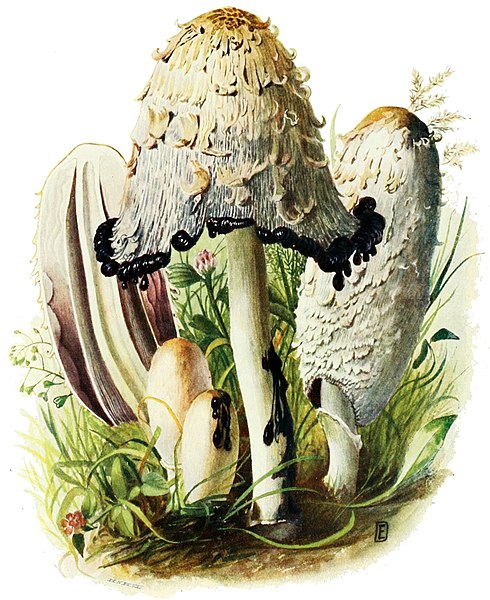
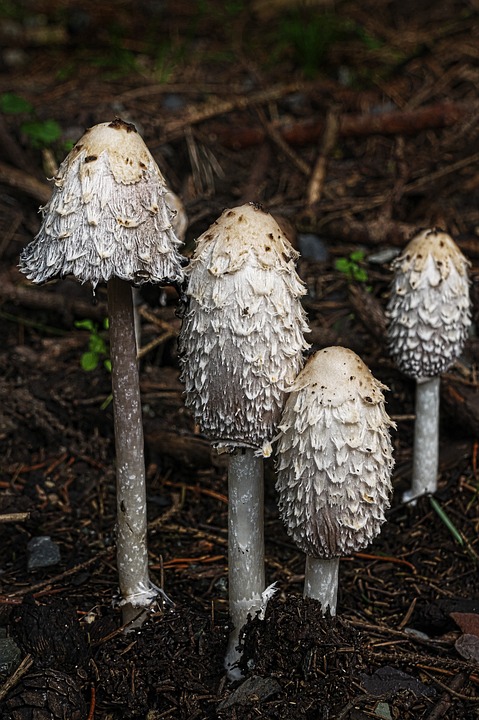
Coprinus comatus, or Shaggy Inkcap (08/06/23-08/12/23)
This mushroom's gills start out pink and turn into a black liquid when it gets old. (Fun fact: Merlin Sheldrake wrote all illustrations in his book, Entangled Life, using ink made from this gill goo!) They're edible when young, and apparently pretty tasty! You have to prepare them fast after harvest because they liquify so quickly. I thought these grew in my neighborhood whenever it rained, but what I was actually seeing was an entirely different species, called Podaxis pistillaris or desert shaggy mane! Which makes more sense because they were always way more powdery than gooey. Relish the temporary nature of everything this week and know that nothing lasts. Pain and pleasure come and go and even the way you experience them shifts over time. Keep on truckin!
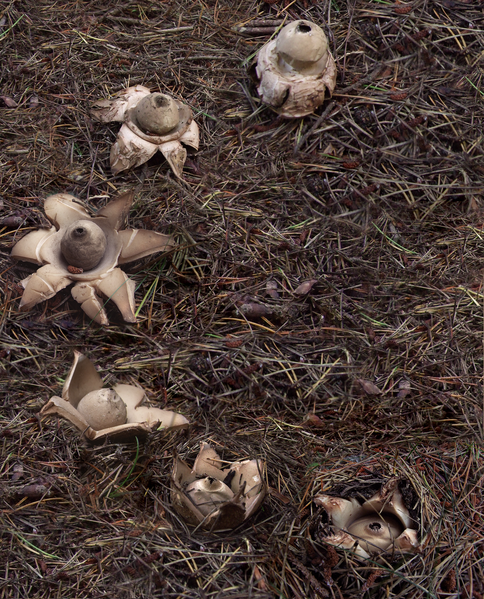
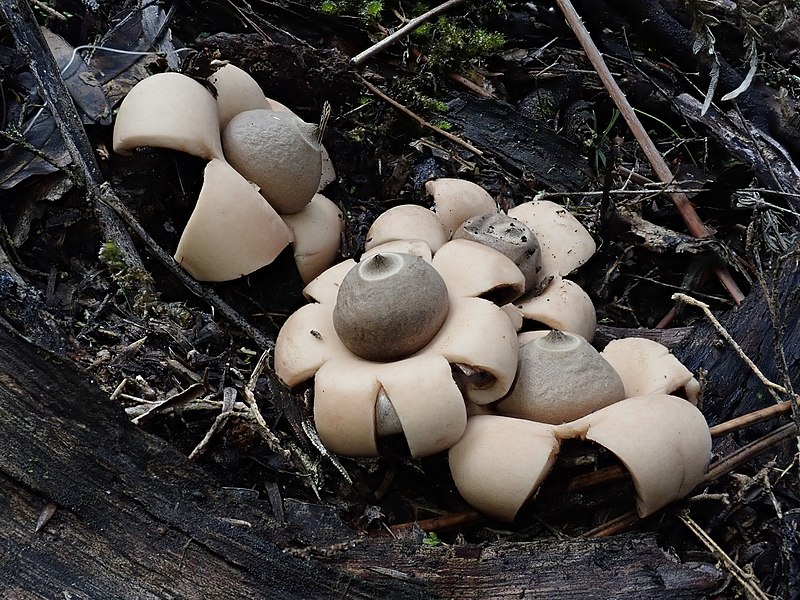
Geastrum triplex, or Collared Earthstar (07/30/23-08/05/23)
When I first saw these irl I was really confused! I thought maybe a regular mushroom had gotten mutated or bitten into that shape but I kept finding more and discovered that earthstars are actually not uncommon where I live and I just don't go outside enough ;). The middle "balloon" part of these mushrooms hold spores that shoot out in a burst of air from the ostiole when it's disturbed by wind, rain, or a living thing. Like a lot of fungal species, these fungi are saprotrophic and eat dead and decaying organic matter. These guys are distributed pretty much everywhere there's a hardwood forest, so if you go looking for 'em you'll likely have luck! They're inedible though, don't try to eat them. This week, remember you're a star on Earth too! People may have a weird reaction to you but that says more about them than you.
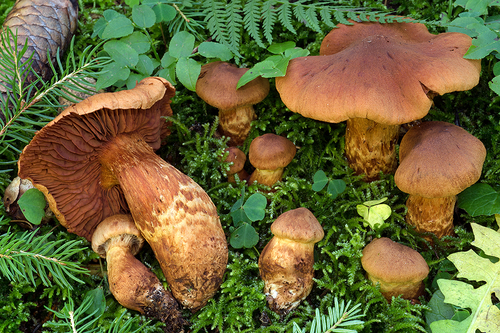 Federico Calledda
Federico Calledda
Cortinarius rubellus, or Deadly Webcap (07/23/23-07/29/23)
These mushrooms are incredibly poisonus and cause kidney failure in people who eat them. They can be found in Japan, England, and North America, but are most common in Europe. I live in the desert so I have a pretty good chance of never running into these guys, which is good because I'm always dangerously tempted to touch every mushroom I see. (bad idea!!) The poison they make is a chemical called orellanine, which is unique to the Orellani family of fungi (all in the genus Cortinarius btw). According to the wikipedia article I looked at, orellanine kills pretty much every kind of living cell by oxidizing them. And there's no known antidote. Brutal, guys. Hope this week you can tap in to your own unique inner ruthlessness and thrive!